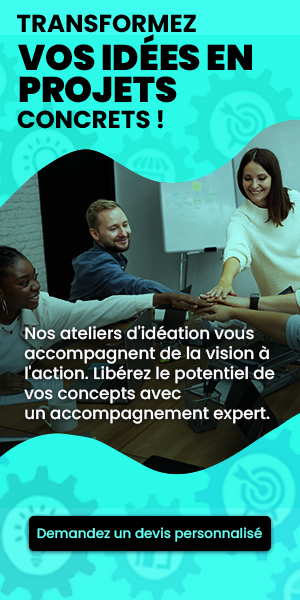Design thinking represents a true revolution in the field of innovation. By placing humans at the heart of the creative process, it offers a unique methodology for identifying problems and generating original solutions. Through a systematic and collaborative approach, teams are encouraged to explore, experiment, and iterate. Whether within companies or personal projects, design thinking enables structured innovation while leveraging the community and collective intelligence to bring forth ideas that truly address the needs of users.
🔥 Nous recommandons Ideamap
Ideamap est l’outil idéal pour un brainstorming ou un projet collaboratif. Grâce son interface facile et à ses fonctions IA, Ideamap booste votre créativité tout en favorisant une meilleure organisation de vos idées pour atteindre vos objectifs.
|
IN BRIEF
|
Design thinking is a dynamic method that allows us to innovate by placing humans at the center of the approach. This methodology is built around several key phases, utilizing various tools that promote creativity and collective intelligence. This article explores how design thinking, in practice, serves as a lever for generating innovative ideas and solving complex problems.
Understanding design thinking
Design thinking is much more than just a method: it is a philosophy centered on user experience. It is based on empathy and understanding the real needs of users. This approach emphasizes collaboration among diverse stakeholders, fostering the emergence of creative solutions adapted to contemporary challenges. By integrating phases of observation, definition, ideation, prototyping, and testing, this method provides a sequenced framework to guide the innovation process.
The essential steps of design thinking
To innovate effectively with design thinking, it is crucial to master its five fundamental steps. The first involves immersing oneself in an empathy phase that allows for a deep understanding of user needs. Next, defining the identified problems guides the thinking towards concrete solutions. The ideation phase follows, encouraging creativity in generating ideas. The creation of simplified prototypes is then essential to test and refine these ideas. Finally, feedback during the testing phase becomes a valuable asset for readjusting and improving solutions.
Design thinking tools to foster innovation
Design thinking comes with a variety of tools that facilitate innovation. Techniques such as brainstorming, empathy maps, decision matrices, and participatory workshops offer a structured framework for idea development. These tools allow for the organization of creative sessions in a smooth and productive manner. Setting up collaborative workshops enables each participant to contribute their perspective, thus enriching the creative process. You can discover more necessary tools for design thinking here.
The role of collective intelligence
At the heart of design thinking lies collective intelligence. By bringing together individuals with varied skills and experiences, teams can approach problems from different angles. This collaborative approach creates a dynamic where every voice matters, allowing for heightened creativity. By leveraging the combined strength of ideas, design thinking becomes a true engine of innovation within the organization. Indeed, the fusion of individual perspectives is what allows for the achievement of new and relevant solutions.
Design thinking and digital transformation
In a context of digital acceleration, design thinking perfectly aligns with digital transformation. By integrating new technologies into its innovation processes, companies can respond swiftly to the ever-changing expectations of users. The creation of digital prototypes and the use of collaborative platforms enhance interaction with users throughout the product development process. This synergy between design thinking and digitalization is essential in today’s innovation landscape. Studies show that the impact of design thinking on the development of innovative products is significant, you can learn more here.
Overview of the challenges to tackle
Despite its numerous advantages, design thinking comes with challenges to overcome during its implementation. Resistance to change within teams, the need for a strong culture of innovation, and the requirement for adequate resources can hinder the adoption of this approach. Additionally, it is essential to avoid certain pitfalls when implementing design thinking to ensure its effectiveness. Understanding these challenges is crucial to moving towards a smooth and productive use of this revolutionary methodology. For more details on these challenges, an in-depth article is available here.
Measuring the impact of design thinking
Ultimately, it is crucial to measure the impact of design thinking initiatives on innovation. Evaluating user satisfaction, the effectiveness of solutions provided, and return on investment are some relevant indicators. Moreover, understanding the evolution of products through design thinking can offer valuable insights for shaping future strategies. To explore how to measure this impact effectively, additional resources are available here.

Design thinking emerges as an essential methodology for companies seeking to innovate effectively and humanely. By centering its approach on the needs and experiences of users, this method transforms how ideas are generated and developed. The focus on empathy allows for the identification of truly relevant solutions, addressing consumer expectations while leveraging collective creativity.
The different steps of design thinking – empathy, definition, ideation, prototyping, and testing – provide a sequenced and structured approach, facilitating the transition from a mere idea to a tangible and functional product. This iterative process encourages experimentation and collaboration, two crucial elements for fostering an innovation-friendly climate. By bringing together multidisciplinary teams, design thinking taps into collective intelligence, thus driving the creation of innovative solutions that can have a significant impact on the market and end-users.
By integrating various tools tailored to each phase of this methodology, companies can maximize their innovation potential. From participatory workshops to rapid prototyping sessions, each tool serves to trigger creativity and test concepts in a secure environment. Moreover, the collaborative approach fosters connections among team members, enriching group dynamics and improving the quality of ideas generated.
Ultimately, design thinking is not limited to creating products that meet a need: it also transforms the managerial innovation of organizations by establishing a culture of continuous learning and adaptation. It is this capacity to evolve and adjust based on user feedback that positions design thinking as an essential lever in the pursuit of sustainable innovation.














